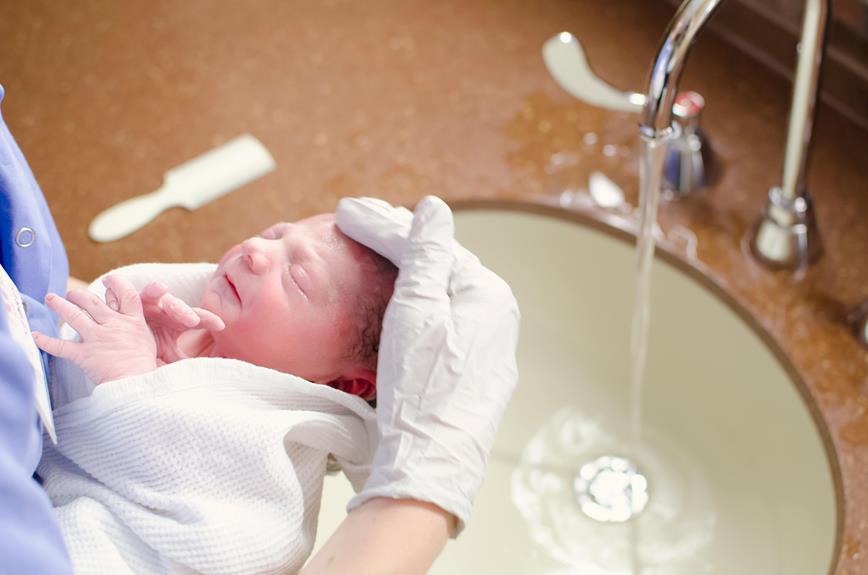
When bathing your newborn, remember to keep the water temperature between 90 to 100 degrees Fahrenheit to prevent scalds or chills. Always support your baby's head and neck while using gentle and controlled movements. Choose gentle, hypoallergenic bathing products free from harsh chemicals, fragrances, and dyes for their sensitive skin. Ensure a stress-free bath time by testing the water temperature beforehand and creating a soothing environment. These tips will help you bath your newborn safely and comfortably.
Importance of Proper Water Temperature
To ensure your newborn's safety during bath time, maintain the water temperature between 90 to 100 degrees Fahrenheit. Water that's too hot can scald your baby's delicate skin, while water that's too cold can lead to chills and discomfort. Use a reliable thermometer to check the temperature before placing your baby in the water. Remember, what might feel comfortably warm to you could be too hot for your little one.
Babies are more sensitive to temperature extremes than adults, so it's crucial to be vigilant about the water temperature throughout the bath. A good practice is to swirl the water around gently to ensure an even distribution of heat. If you need to adjust the temperature, do so gradually to avoid sudden changes that could startle or harm your baby.
Handling Techniques for Newborn Safety
Ensure proper support for your newborn's head and neck while bathing to prevent any accidental injuries. When lifting your baby in and out of the bath, always keep one hand supporting the head and neck, and the other hand supporting the bottom. This will help maintain your baby's stability and reduce the risk of slipping or falling.
While bathing your newborn, it's crucial to use gentle and controlled movements. Avoid sudden or jerky motions that could startle your baby. Instead, move slowly and steadily, ensuring a calm and secure bathing experience.
When washing your baby's delicate skin, use mild, fragrance-free baby soap and warm water. Gently pat your baby dry with a soft towel, paying special attention to the folds of the skin to prevent irritation or infection.
Remember to keep a secure grip on your baby at all times during the bath. A wet and slippery baby can be challenging to hold onto, so make sure you have a firm grasp to prevent any accidents. By following these handling techniques, you can ensure a safe and enjoyable bathing experience for both you and your newborn.
Choosing the Right Bathing Products
When selecting bathing products for your newborn, prioritize gentle and hypoallergenic options to protect their delicate skin. Look for baby washes and shampoos that are specifically formulated for newborns, as these are designed to be mild and gentle. Opt for products that are free from harsh chemicals, fragrances, and dyes to reduce the risk of irritation or allergic reactions. It's essential to choose products that are soap-free and pH-balanced to help maintain the natural balance of your baby's skin.
When it comes to moisturizers, select ones that are fragrance-free and designed for sensitive skin. Keeping your baby's skin well-hydrated is crucial, especially in the early months when their skin is still developing. Look for products that contain natural ingredients like oatmeal or shea butter, which can help soothe and nourish your baby's delicate skin.
Tips for a Stress-Free Bath Time
Prioritize creating a calming environment by ensuring the water temperature is comfortable and having all necessary supplies within reach for a stress-free bath time with your newborn. Begin by gathering a soft towel, baby wash, a cup for rinsing, and clean clothes.
Maintain a room temperature of around 75 degrees Fahrenheit to prevent your baby from getting cold during the bath. Keep the bathing area warm by using a space heater or heating the room beforehand. Test the water temperature using your wrist or a thermometer to ensure it's between 90-100 degrees Fahrenheit. Fill the tub with just a few inches of water to prevent your baby from slipping under the surface.
Use a gentle touch and talk to your baby in a soothing voice to help them feel secure. After the bath, quickly wrap your baby in the warm towel to prevent them from getting cold. By following these tips, you can create a relaxing bath time routine for your newborn.
Conclusion
In conclusion, by following these safe bathing practices, you can ensure a comfortable and enjoyable experience for your newborn.
Remember to always check the water temperature, handle your baby with care, use gentle bathing products, and create a calming atmosphere during bath time.
With these tips in mind, you can confidently bond with your little one during this special time together.




